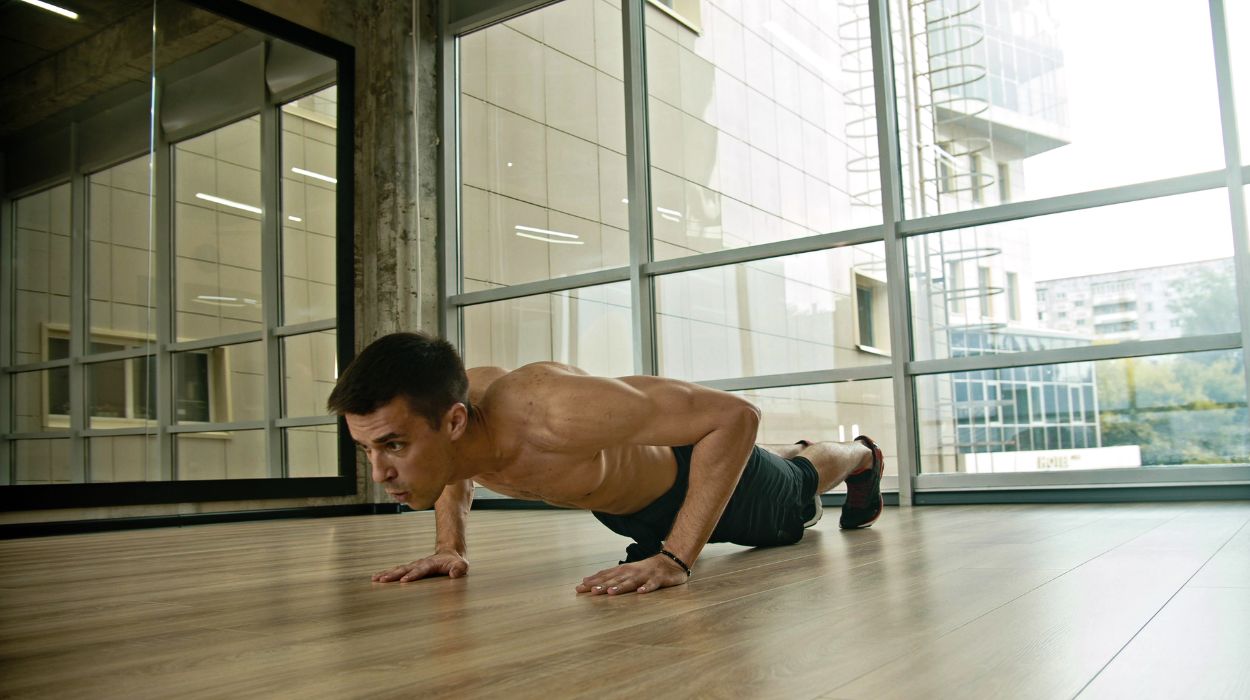
People try exercise, diet, and the best fat burners and weight loss supplements to lower body fat. But even with all that, losing weight from your midsection can be tough. Fortunately, we’ve compiled seven bodyweight ab exercises to help you achieve all your fitness goals.
Whether you’re starting or advancing, these exercises target your abdominal muscles and engage your entire core. No equipment is needed — just your body weight, proper form, and determination.
Best Bodyweight Core Exercises To Train Your Abs
- Plank
- Reverse Crunch
- Mountain Climber
- Bicycle Crunch
- Russian Twist
- Flutter Kicks
- Leg Raises
Best Bodyweight Ab Exercises For Strong Abs
Whether your goal is weight loss or muscle-building, below are seven ways to get toned.
The Plank
The plank offers you a strong core foundation.
The plank is a core-strengthening exercise that targets the rectus abdominis, transverse abdominis, and obliques — basically, your entire core.
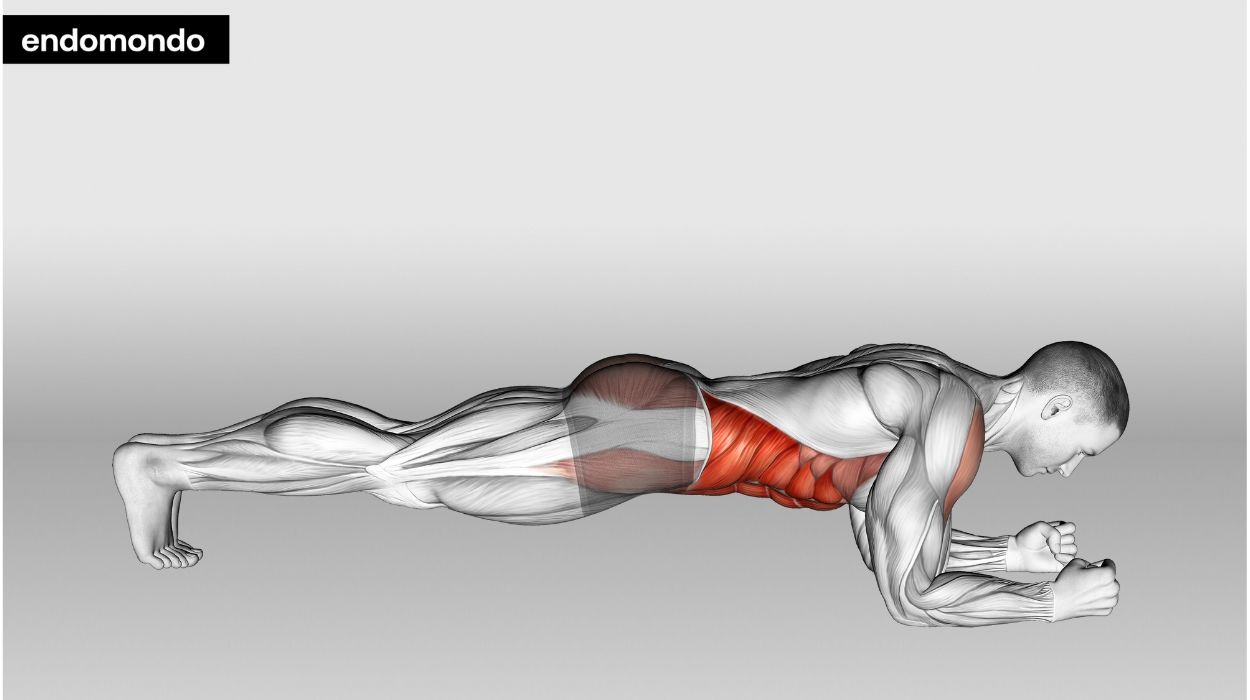
How to do:
- Start in a push-up position but with your forearms on the ground and not your palms.
- Hold this position and with a straight neutral spine, engage your core and maintain proper alignment. Avoid sagging your hips or lifting your buttocks too high.
- Inhale before starting, exhale while getting into position, and then breathe normally.
Tips:
- Maintain a straight line from head to heels to engage your core effectively.
- Breathe steadily and avoid holding your breath to stay relaxed and focused.
- Incorporate variations like side planks or forearm planks to target different areas of your core for a well-rounded workout.
Optimal Sets and Reps: 3 sets of 30 seconds.
Reverse Crunch
Reverse crunches set your lower abs on fire.
Any effective bodyweight ab workout should include the reverse crunch. This inverted variation helps you develop strong muscles and defines your lower abs, helping you get the coveted six-pack faster.
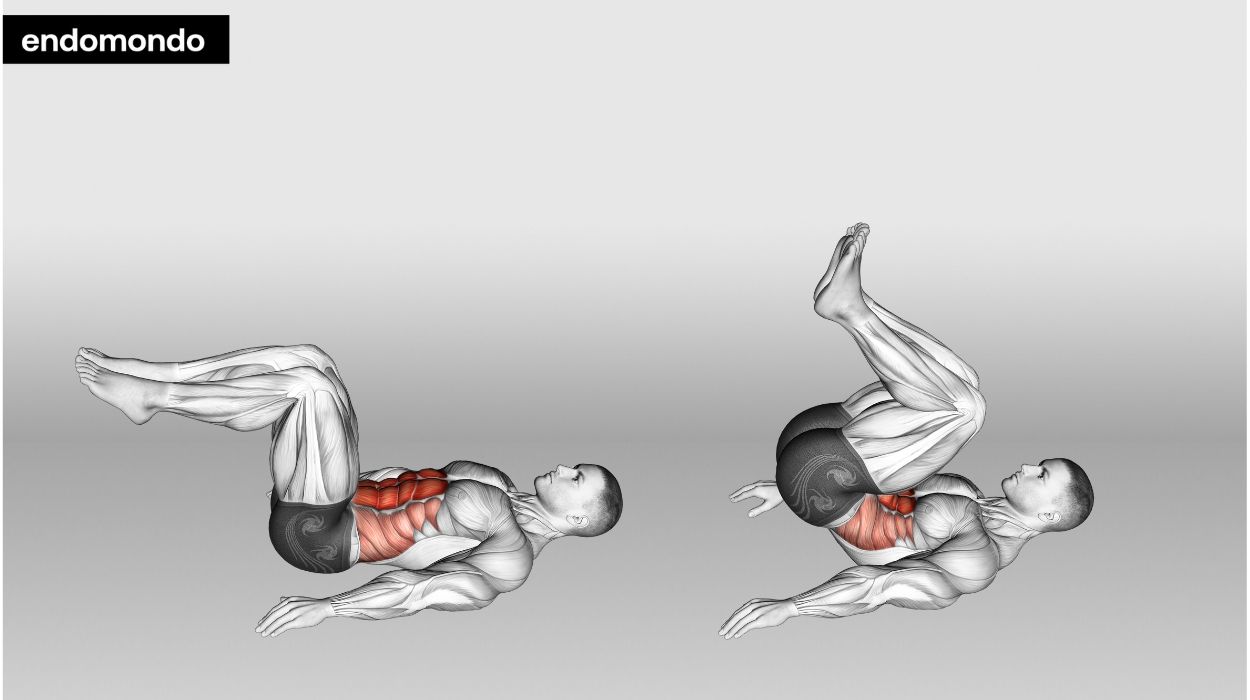
How to do:
- Get into your starting position by lying on your back with your legs bent at the knees.
- Feet touching, lift your hips off the ground bringing your knees towards your chest.
- After getting to the top, slowly lower them.
- Keep the motion controlled, and avoid using momentum or swinging your legs.
- Exhale as you lift your hips off the ground; inhale as you lower.
Tips:
- Keep your lower back pressed into the floor throughout the movement.
- Focus on a controlled, slow tempo for maximum muscle engagement.
- Gradually increase difficulty with added resistance or more repetitions.
Optimal Sets and Reps: 3 sets of 12-15 reps.
Mountain Climber
Mountain climbers are where cardio meets the core. It targets the abs, obliques, and right and left hip flexors.
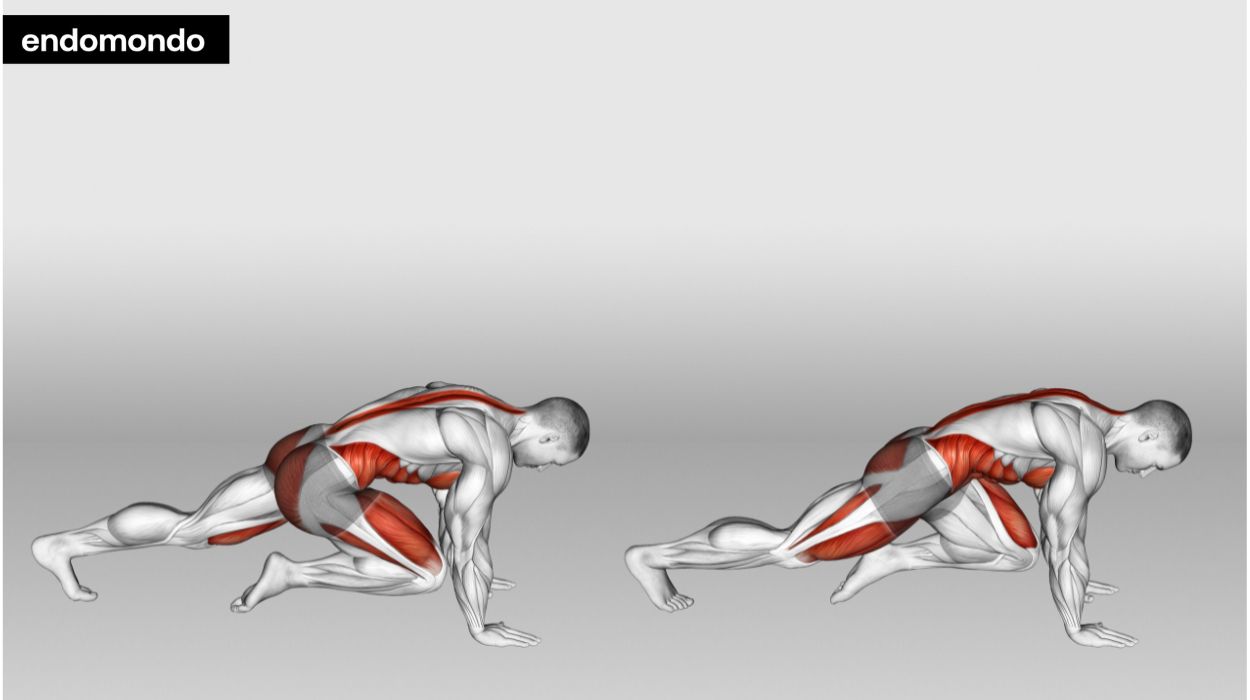
How to do:
- Start in a high plank position or the push-up position.
- Initiate this bodyweight ab workout by bringing one knee at a time toward your chest in a running motion.
- Avoid sagging hips or rounding the right or left shoulder as you switch legs.
- Exhale as you bring your knees towards your chest, and inhale as you return to the starting position.
Tips:
- Keep your core engaged and body in a straight line from head to heels.
- Move your knees towards your chest quickly while maintaining proper form.
- Coordinate your breathing with the leg movements to sustain your endurance.
Optimal Sets and Reps: 3 sets of 10-12 reps each time.
Bicycle Crunch
Bicycle crunches fully engage your obliques.
The bicycle crunch is a popular exercise targeting upper and lower abs and obliques.
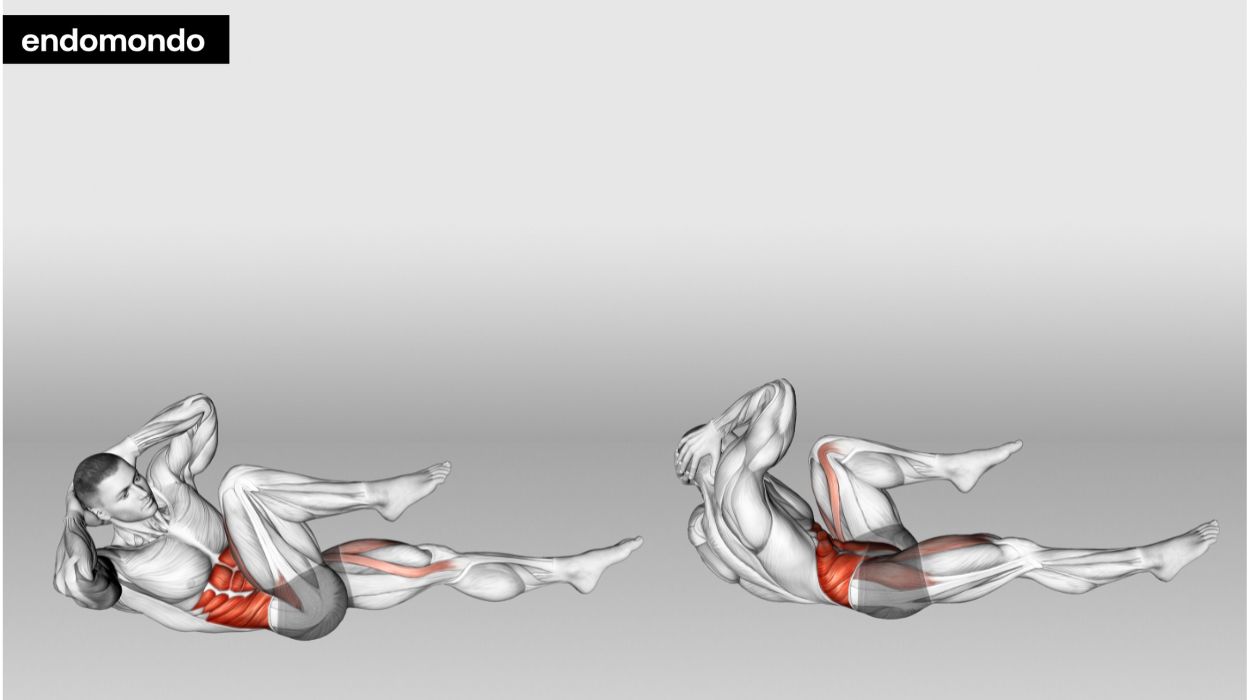
How to do:
- Lie on your back with your hands and elbows wide behind your head.
- Start with your right elbow touching the left knee while extending the opposite leg.
- Do the same with the left elbow to the right knee.
- Inhale as you switch sides, exhale as you twist, and bring your elbow and knee to touch.
Tips:
- Keep your elbows wide and avoid pulling on your head to prevent neck strain.
- Engage your core muscles throughout the entire range of motion for maximum effectiveness.
- Exhale as you bring your elbow to the opposite knee, emphasizing the twist to engage your obliques.
Optimal Sets and Reps: 3 sets of 15-20 reps.
Russian Twist
The Russian twist targets the obliques and engages the entire core.
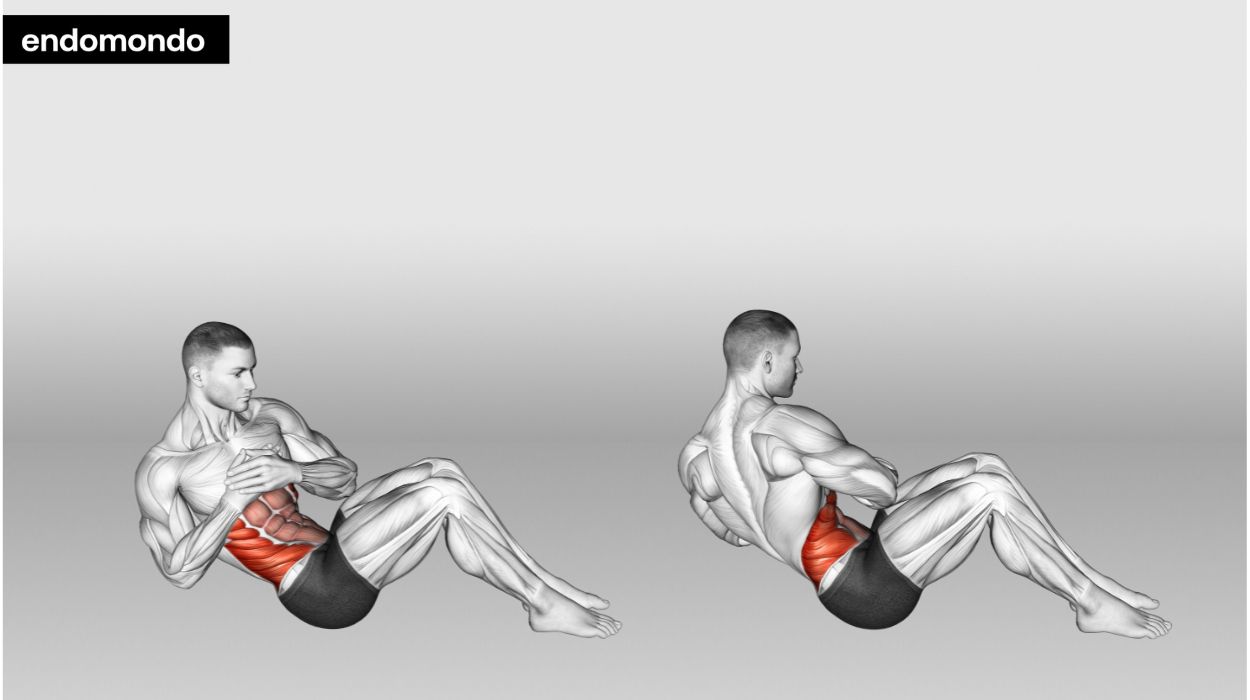
How to do:
- Sit on the ground with your knees bent and slightly lean backward, keeping your back straight.
- Twist your torso from side to side, almost touching the ground on each side.
- Engage your core throughout the movement and avoid rounding your back during the exercise.
- Inhale at the center, exhale as you twist.
Tips:
- Sit up tall with your back straight, engaging your core muscles.
- Twist your torso and touch the floor on each side with your hands or a weight.
- Keep your feet off the ground for an added challenge to target obliques.
Optimal Sets and Reps: 3 sets of 12-15 reps.
Flutter Kicks
Flutter Kicks set your lower abs on fire. This exercise targets the lower abs, hip flexors, and quadriceps.
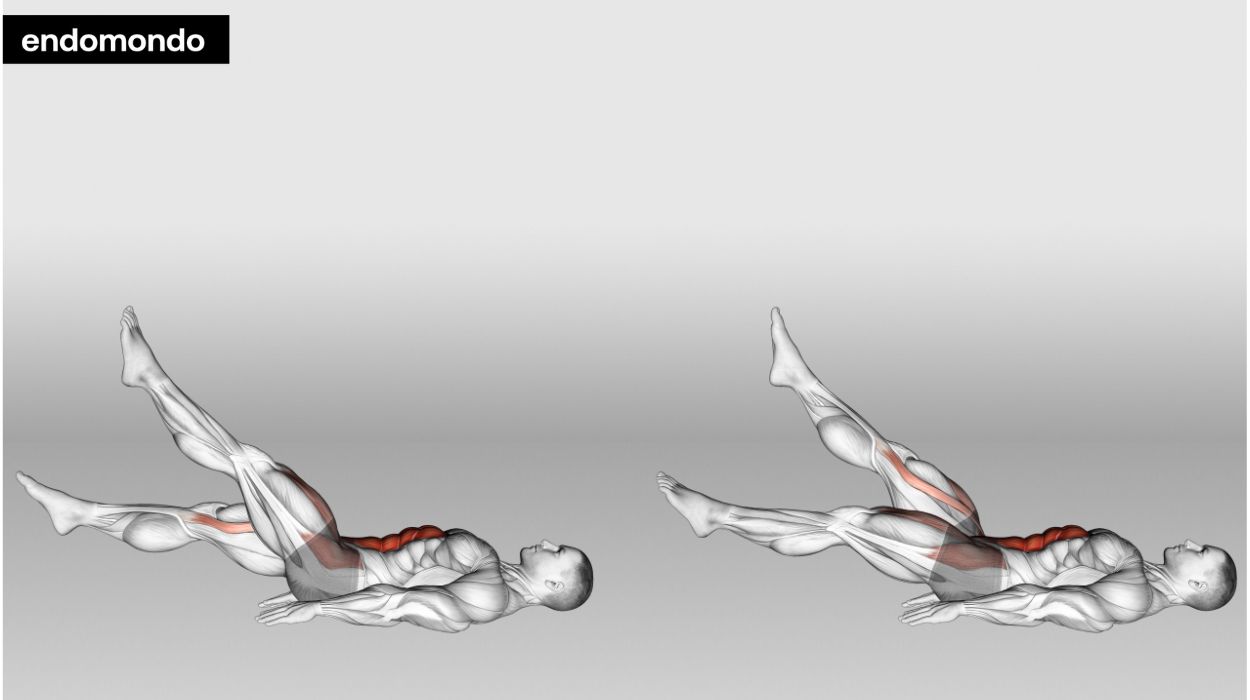
How to do:
- Lie on your back with your legs straight, and place your hands under your hips for added support.
- Lift both legs a few inches off the ground.
- In that position, lift the right leg higher than your left leg, then continuously switch in a scissor-like movement, keeping your legs extended.
- Engage your core and keep your lower back pressed into the ground.
- Focus on controlled and steady movements, avoiding lifting your lower back.
- Focusing on one leg, inhale at the top position; and exhale at the lowest.
Tips:
- Lie flat on your back with your hands under your hips for support.
- Keep your legs straight and alternate small, rapid kicks up and down.
- Engage your core muscles throughout the exercise to protect your lower back.
Optimal Sets and Reps: 3 sets of 20-25 reps.
Leg Raises
It is perfect for targeting the lower abs. Leg raise is a bodyweight core workout that targets the lower abs while engaging the hip flexors and extensors.
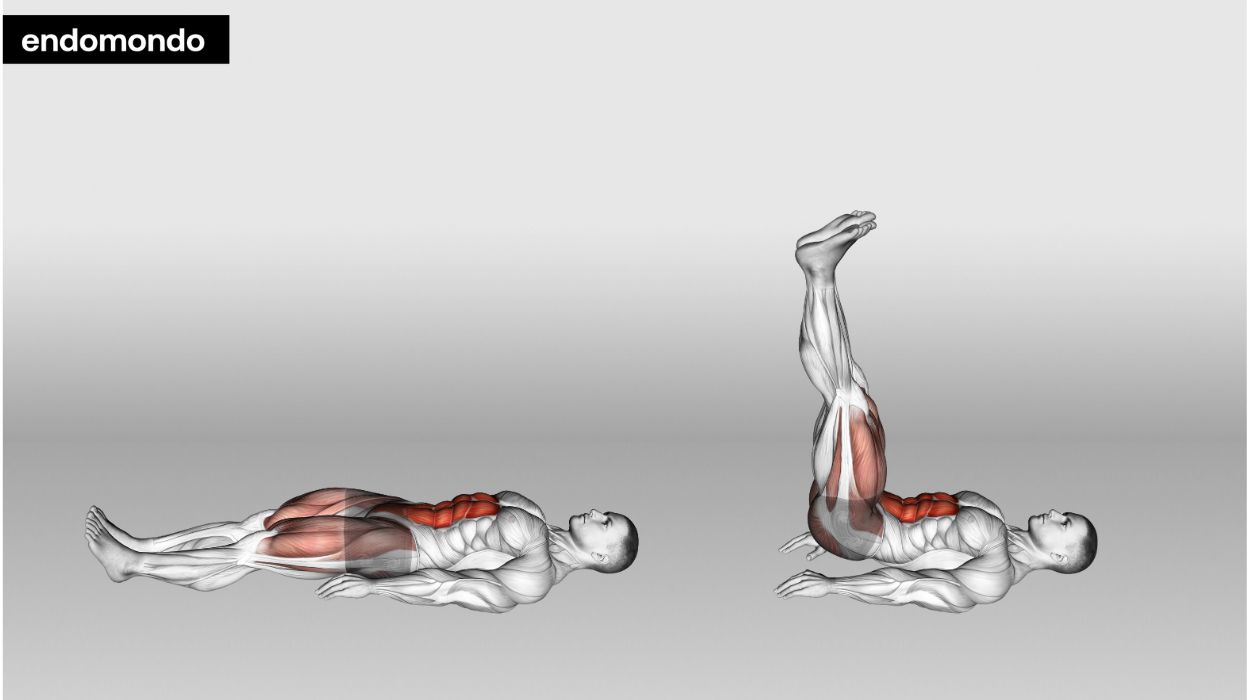
How to do:
- Lie on your back with your legs fully extended with palms facing down and under your hips for added support.
- Simultaneously lift your legs towards the ceiling while pressing your lower back into the ground.
- Engage your core throughout the movement and avoid swinging your legs or arching your back.
- Inhale as you lift your legs, exhale as you slowly lower them back off the floor.
Tips:
- Lie flat on your back, keeping your hands under your hips for support.
- Lift your legs upward, keeping them straight, until they are perpendicular to the floor.
- Lower your legs slowly without arching your back to engage your lower abs effectively.
Optimal Sets and Reps: 3 sets of 10-12 reps.
Common Risks For Bodyweight Exercises
While bodyweight ab exercises can be highly effective for strengthening the core, it’s important to be aware of common risks associated with these exercises. Some potential risks and their corresponding solutions are:
Neck And Shoulder Strain

Placing excessive strain on the neck and shoulders during bodyweight exercises can lead to discomfort or injury. To avoid this, relax your neck and engage your core muscles to take some pressure off the neck and shoulders.
Lower Back Pain
Poor form or lack of core engagement can lead to lower back pain. Ensure your lower back stays pressed against the ground, engage your core, and use controlled movements.
Wrist Discomfort
Some bodyweight exercises, like planks, can strain the wrists if wrongly done. To alleviate this, distribute the weight evenly through your hands by aligning your wrists with your shoulders.
Overtraining
Performing excessive repetitions or training without proper rest can increase the risk of overtraining and muscle fatigue. Allow your abdominal muscles adequate rest days in between workouts.
By being mindful, you can minimize the chances of injury and maximize the benefits of bodyweight ab exercises.
Experts’ Advice For Bodyweight Ab Workout
Here are a few important pieces of advice from experts on bodyweight ab training:
Focus On Form
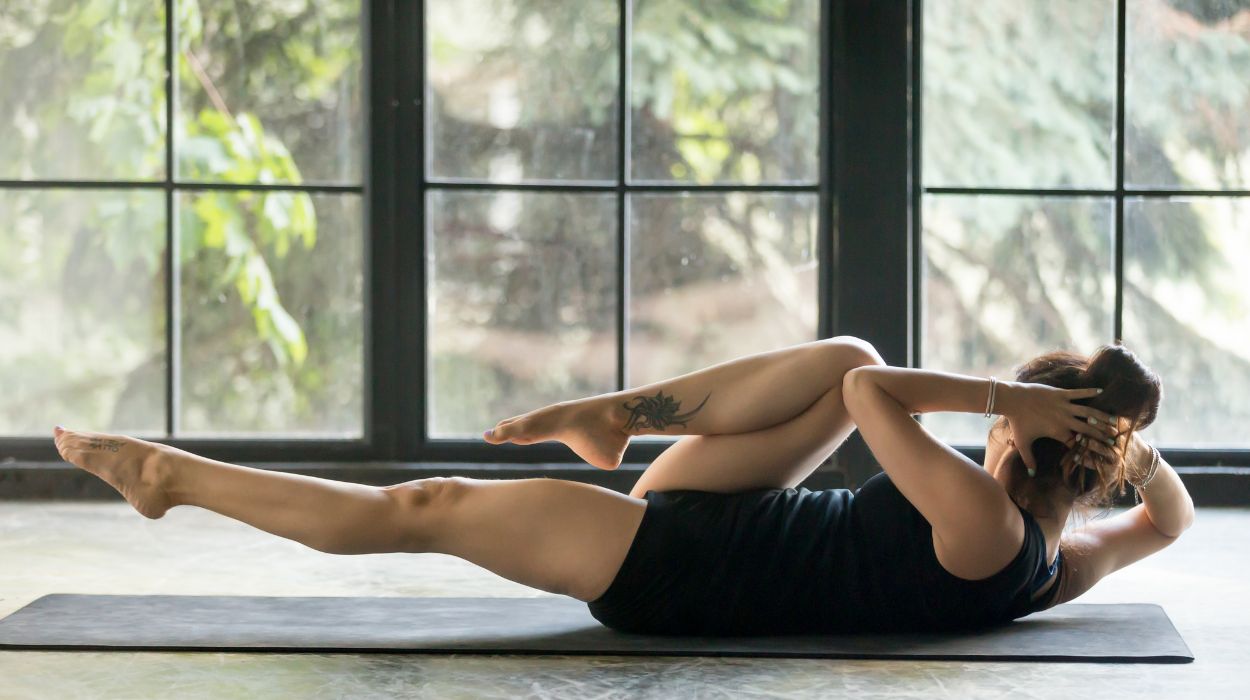
Maintain a neutral spine and an engaged core to reduce any excessive spinal load.[1] Follow exercise recommendations fully and use proper form to alleviate excessive strain on the neck, shoulder blades, and lower and upper back.
Aim For Progressive Overload
If your goal is to build muscle and strength gradually, progressive overload[2] is the only way. Start with exercises that match your fitness level and gradually increase the difficulty.
Since you’re using body weight here, you may add variations, increase repetitions,[3] or explore advanced progressions. This helps prevent plateaus and keeps your muscles challenged.
Prioritize Core Stability
Studies support that intentional core strength training offers better postural control and stability.[4] Building core stability is also quintessential for overall strength and injury prevention.[5] Along with exercises focusing on flexion and rotation, incorporate core abs workouts emphasizing stability, such as planks.
Don’t Forget About Nutrition
Proper nutrition is vital in growing and healing the muscles[6] you work hard to strengthen. Prioritize proteins,[7] complex carbs,[8] veggies, fruits, and healthy fats.
Maintain a balanced diet, focus on whole foods, and ensure you’re in a caloric deficit if your goal is to reduce body fat and reveal your ab muscles. What’s more, you may add vitamin or protein powder supplementation.
Consistency Is Key
Building strong abs takes time, progression, and consistency. Aim for regular workouts, stick to your routine, and be patient with the progress.
Also, remember to warm up and cool down when on a bodyweight ab workout routine. Finally, consult with a fitness professional or trainer if you have any specific concerns or questions about your bodyweight ab training. They can provide personalized guidance and help tailor a routine to suit your needs and goals.
Summary
You now know effective bodyweight ab exercises for a full 15-minute ab workout routine.
These exercises offer diverse challenges to keep your core engaged and progressing. They are all bodyweight workouts, but you can advance by doing challenging variations.
Remember to prioritize proper form, gradually increase the intensity and reps, and listen to your body’s needs. A healthy diet and supplements as added nutrition may also help. Consistency and patience are needed for a toned core, so stay committed to your fitness journey.
Keep pushing yourself, and remember, a toned core is within your reach through these bodyweight core exercises. So get ready to feel the burn, see the results, and enjoy the benefits of a strong and sculpted midsection.
Frequently Asked Questions
You can achieve defined abs through consistent bodyweight exercises targeting the abdominal muscles.
Yes, 15-minute ab workouts can effectively strengthen and tone the core with proper form and intensity.
Typically, 10-15 minutes of focused ab workout can effectively engage and challenge the core muscles.
No, it’s generally recommended to allow for rest and recovery between ab workouts to give the muscles time to repair and strengthen.
Resources
- Oliva-Lozano, J.M. and Muyor, J.M. (2020). Core Muscle Activity during Physical Fitness Exercises: A Systematic Review. [online] 17(12), pp.4306–4306. doi:https://doi.org/10.3390/ijerph17124306.
- Vlad Adrian Geanta and Ardelean Viorel Petru (2021). Improving muscle size with Weider’s principle of progressive overload in non-performance athletes. [online] ResearchGate. Available at: https://www.researchgate.net/publication/358008997_Improving_muscle_size_with_Weider’s_principle_of_progressive_overload_in_non-performance_athletes
- Plotkin, D.L., Coleman, M., Van, D.W., Maldonado, J., Oberlin, D.J., Israetel, M., Feather, J., Alto, A., Vigotsky, A.D. and Schoenfeld, B.J. (2022). Progressive overload without progressing load? The effects of load or repetition progression on muscular adaptations. [online] 10, pp.e14142–e14142. doi:https://doi.org/10.7717/peerj.14142.
- Hsu, S.-L., Oda, H., Saya Shirahata, Watanabe, M. and Sasaki, M. (2018). Effects of core strength training on core stability. [online] 30(8), pp.1014–1018. doi:https://doi.org/10.1589/jpts.30.1014.
- Huxel, K.C. and Anderson, B.L. (2013). Core Stability Training for Injury Prevention. [online] 5(6), pp.514–522. doi:https://doi.org/10.1177/1941738113481200.
- Mielgo-Ayuso, J. and Fernández-Lázaro, D. (2021). Nutrition and Muscle Recovery. [online] 13(2), pp.294–294. doi:https://doi.org/10.3390/nu13020294.
- Morton, R.W., Murphy, K., McKellar, S.R., Schoenfeld, B.J., Menno Henselmans, Helms, E.R., Aragon, A.A., Devries, M.C., Banfield, L., Krieger, J. and Phillips, S.M. (2017). A systematic review, meta-analysis and meta-regression of the effect of protein supplementation on resistance training-induced gains in muscle mass and strength in healthy adults. [online] 52(6), pp.376–384. doi:https://doi.org/10.1136/bjsports-2017-097608.
- Menno Henselmans, Bjørnsen, T., Hedderman, R. and Vårvik, F.T. (2022). The Effect of Carbohydrate Intake on Strength and Resistance Training Performance: A Systematic Review. [online] 14(4), pp.856–856. doi:https://doi.org/10.3390/nu14040856.




